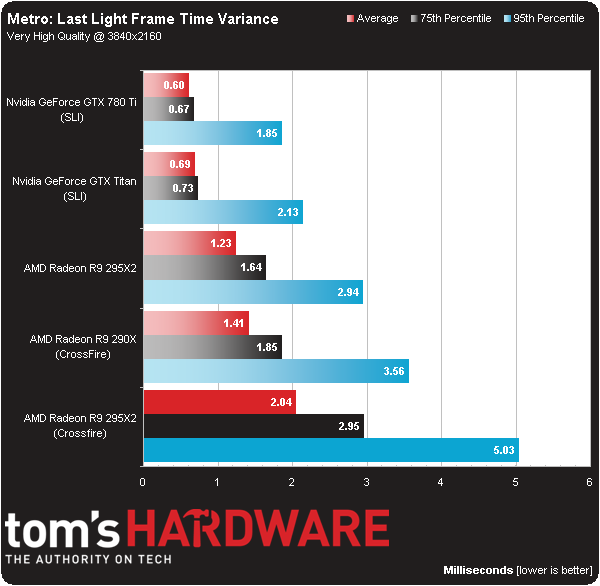Update: Radeon R9 295X2 8 GB In CrossFire: Gaming At 4K
We spent our weekend benchmarking the sharp-looking iBuyPower Erebus loaded with a pair of Radeon R9 295X2 graphics cards. Do the new boards fare better than the quad-GPU configurations we've tested before, or should you stick to fewer cards in CrossFire?
Results: Metro: Last Light
By this point, I was hoping that one little driver toggle fix would solve the performance issues throughout our benchmark suite. Unfortunately, the taxing Metro: Last Light benchmark shows that there are still issues to be worked out. FCAT indicates 49 average frames per second, Fraps confirms, and our original quad-CrossFire piece also reported 49 FPS.
Frame rate over time makes it pretty clear that there’s some sort of bottleneck in the Metro benchmark. Thinking this might be limited to the canned test, we played through pieces of the actual game and found that performance didn’t improve there, either.
There’s clearly a bottleneck of some sort in play, and given the close proximity of four different configurations, it might not be an AMD-only problem. With that said, AMD didn’t have any feedback regarding what might be happening when we asked.
The frame time variance figures show only that two Radeon R9 295X2s land at the back of the pile. A 5 ms worst-case figure shouldn’t be construed as bad, though. Moreover, our experiences in-game and with the built-in benchmark didn’t turn up issues with stuttering.
Quad-CrossFire does demonstrate the large variance spikes, though again, the experience isn’t made perceptibly worse by them.
Get Tom's Hardware's best news and in-depth reviews, straight to your inbox.
-
redgarl I always said it, more than two cards takes too much resources to manage. Drivers are not there either. You are getting better results with simple Crossfire. Still, the way AMD corner Nvidia as the sole maker able to push 4k right now is amazing.Reply -
BigMack70 I personally don't think we'll see a day that 3+ GPU setups become even a tiny bit economical.Reply
For that to happen, IMO, the time from one GPU release to the next would have to be so long that users needed more than 2x high end GPUs to handle games in the mean time.
As it is, there's really no gaming setup that can't be reasonably managed by a pair of high end graphics cards (Crysis back in 2007 is the only example I can think of when that wasn't the case). 3 or 4 cards will always just be for people chasing crazy benchmark scores. -
frozentundra123456 I am not a great fan of mantle because of the low number of games that use it and its specificity to GCN hardware, but this would have been one of the best case scenarios for testing it with BF4.Reply
I cant believe the reviewer just shrugged of the fact that the games obviously look cpu limited by just saying "well, we had the fastest cpu you can get" when they could have used mantle in BF4 to lessen cpu usage. -
Matthew Posey The first non-bold paragraph says "even-thousand." Guessing that should be "eleven-thousand."Reply -
Haravikk How does a dual dual-GPU setup even operate under Crossfire? As I understand it the two GPUs on each board are essentially operating in Crossfire already, so is there then a second Crossfire layer combining the two cards on top of that, or has AMD tweaked Crossfire to be able to manage them as four separate GPUs? Either way it seems like a nightmare to manage, and not even close to being worth the $3,000 price tag, especially when I'm not really convinced that even a single of those $1,500 cards is really worth it to begin with; drool worthy, but even if I had a ton of disposable income I couldn't picture myself ever buying one.Reply




